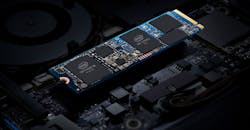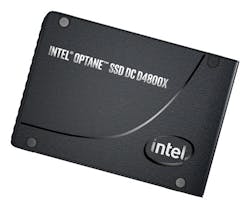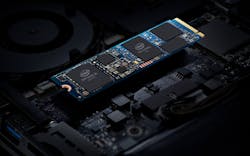Whether server solutions or embedded applications on the edge, Intel has been pushing its non-volatile Optane technology across the board. Optane is now available in multiple form factors, including DIMMs that support persistent-memory programming, dual-port NVMe SSDs, and everything in between.
The Intel Optane DC U.2 D4800X SSD (Fig. 1) targets mission-critical applications on servers and cloud farms. Its dual-port, NVMe interface provides high-speed access to its non-volatile storage. The SSD is 9X faster than a dual-port NAND-based solution that’s under write pressure. The family comes in a 750-GB version with a PCI Express (PCIe) 3.0 x4 interface. A PCIe card form factor is available as well.
1. Intel’s D4800X is a dual-port SSD designed for mission-critical environments.
The DIMM-based solution (Fig. 2) provides persistent-memory support. The Optane DC Persistent Memory module is available in capacities of 128, 256, and 512 GB. The module is pin-compatible with DRAM, although the motherboard BIOS may need to be updated to handle configuration. It’s designed to work with Intel’s latest Xeon processors. The DIMMs are supported by the open-source Persistent Memory Toolkit.
2. The DIMM-based Optane solution offers persistent-memory support.
The M.2 H10 memory module (Fig. 3) takes a slightly different approach by combining two non-volatile memory technologies: flash memory and Intel Optane DC memory. It mixes the high capacity and low price of quad-level-cell (QLC) 3D NAND technology with the higher performance of Optane DC storage.
3. Intel’s latest M.2 H10 memory module combines QLC flash with Optane storage.
The H10 is available in 16-GB/256-GB Optane/flash memory, 32-GB/512-GB and 32-GB/1-TB configurations. The 80-mm module will work in any system that can support M.2 flash storage. They all have a x4 PCIe 3.0 interface.
Optane DC memory isn’t needed for all applications, but many can benefit from its durability and performance. It provides higher performance than NAND flash while providing non-volatile storage capabilities. These days, it’s not unusual to have a tiered memory structure with on-chip SRAM cache, DRAM, Optane DC, and flash storage.
About the Author
William G. Wong
Senior Content Director - Electronic Design and Microwaves & RF
I am Editor of Electronic Design focusing on embedded, software, and systems. As Senior Content Director, I also manage Microwaves & RF and I work with a great team of editors to provide engineers, programmers, developers and technical managers with interesting and useful articles and videos on a regular basis. Check out our free newsletters to see the latest content.
You can send press releases for new products for possible coverage on the website. I am also interested in receiving contributed articles for publishing on our website. Use our template and send to me along with a signed release form.
Check out my blog, AltEmbedded on Electronic Design, as well as his latest articles on this site that are listed below.
You can visit my social media via these links:
- AltEmbedded on Electronic Design
- Bill Wong on Facebook
- @AltEmbedded on Twitter
- Bill Wong on LinkedIn
I earned a Bachelor of Electrical Engineering at the Georgia Institute of Technology and a Masters in Computer Science from Rutgers University. I still do a bit of programming using everything from C and C++ to Rust and Ada/SPARK. I do a bit of PHP programming for Drupal websites. I have posted a few Drupal modules.
I still get a hand on software and electronic hardware. Some of this can be found on our Kit Close-Up video series. You can also see me on many of our TechXchange Talk videos. I am interested in a range of projects from robotics to artificial intelligence.





